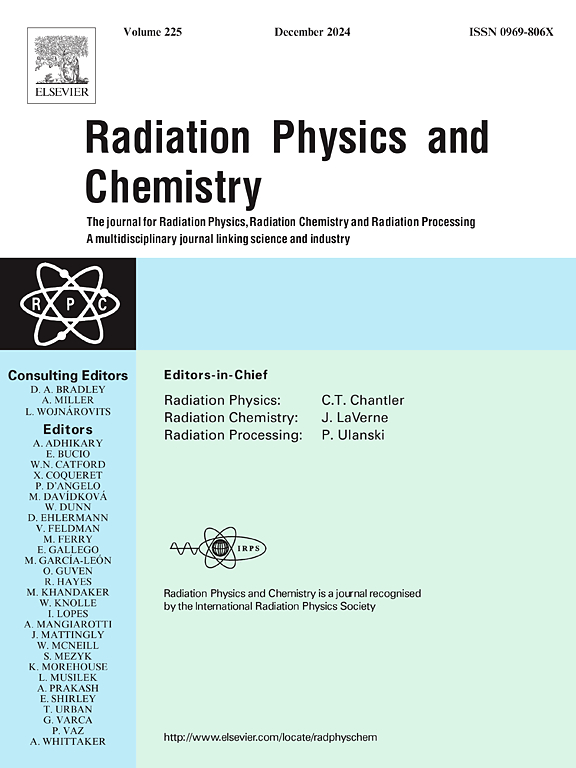掺杂 Nd3+ 离子的硼磷酸镉玻璃的光学特性和 γ 射线衰减能力
IF 2.8
3区 物理与天体物理
Q3 CHEMISTRY, PHYSICAL
引用次数: 0
摘要
在本研究中,研究了 Nd2O3/B2O3 取代对掺杂 Nd2O3 的磷酸硼镉玻璃的物理、光学特性和 γ 射线衰减能力的影响。为此,采用熔体淬火技术合成了四种化学式为 (25-z)B2O3-zNd2O3-5Na2O-40P2O5-30CdO 的玻璃样品,其中 z 分别为 0.0(Nd-1)、0.5(Nd-2)、1.0(Nd-3)和 1.5(Nd-4)mol%。Nd-1 和 Nd-4 样品的密度(ρ)在 3.16 ± 0.02 g/cm3 至 3.53 ± 0.02 g/cm3 的范围内得到了改善。此外,随着玻璃网络中 Nd2O3 含量的增加,摩尔体积 (Vm) 从 39.46 ± 0.01 cm3/mol 增加到 40.16 ± 0.01 cm3/mol。直接光隙(EgDirect)从 4.439 ± 0.001 eV 降至 4.079 ± 0.001 eV,而间接光隙(EgIndirect)从 3.843 ± 0.001 eV 降至 3.607 ± 0.001 eV。厄巴赫能量从 0.318 ± 0.001 提高到 0.243 ± 0.001 eV。线性折射率(n)随着 Nd2O3 替代率的增加而提高。质量(MAC)和线性(LAC)系数验证了以下顺序:(Nd-1)MAC,LAC)<;(Nd-2)MAC,LAC)<;(Nd-3)MAC,LAC)<;(Nd-4)MAC,LAC)。半(HVL)值层的顺序为:(Nd-1)HVL >(Nd-2)HVL >(Nd-3)HVL >(Nd-4)HVL 。因此,所建议的玻璃可被视为具有光学和辐射衰减应用前景的材料。本文章由计算机程序翻译,如有差异,请以英文原文为准。
Optical properties and γ-ray attenuation capacity of cadmium boro-phosphate glasses doped with Nd3+ ions
In the present work, the role Nd2O3/B2O3 substitution on the physical, optical properties, and γ-ray attenuation competence of Nd2O3-doped cadmium boro-phosphate glasses was investigated. For this purpose, four glasses with chemical formula (25-z)B2O3-zNd2O3–5Na2O–40P2O5–30CdO samples, where z is equal to 0.0 (Nd-1), 0.5 (Nd-2), 1.0 (Nd-3), and 1.5 (Nd-4) mol% were synthesized using the melt quenching technique. The density (ρ) was improved in the range of 3.16 ± 0.02 g/cm3 to 3.53 ± 0.02 g/cm3 for Nd-1 and Nd-4 samples. Also, the molar volume (Vm) was enhanced from 39.46 ± 0.01 cm3/mol to 40.16 ± 0.01 cm3/mol as Nd2O3 content increased in the glass networks. The direct optical gap ( reduced from 4.439 ± 0.001 eV to 4.079 ± 0.001 eV, while the indirect optical gap ( reduced from 3.843 ± 0.001 to 3.607 ± 0.001 eV. The Urbach's energy was raised from 0.318 ± 0.001 to 0.243 ± 0.001 eV. The linear refractive index (n) was enhanced as Nd2O3 substitution ratio increased. Mass (MAC) and linear (LAC) coefficients verified the order: (Nd-1)MAC, LAC)<(Nd-2)MAC, LAC)<(Nd-3)MAC, LAC)<(Nd-4)MAC, LAC). The half (HVL) value layer obeyed the order: (Nd-1)HVL >(Nd-2)HVL >(Nd-3)HVL >(Nd-4)HVL. Therefore, the suggested glasses can be considered as promising materials for optical and radiation attenuation applications.
求助全文
通过发布文献求助,成功后即可免费获取论文全文。
去求助
来源期刊

Radiation Physics and Chemistry
化学-核科学技术
CiteScore
5.60
自引率
17.20%
发文量
574
审稿时长
12 weeks
期刊介绍:
Radiation Physics and Chemistry is a multidisciplinary journal that provides a medium for publication of substantial and original papers, reviews, and short communications which focus on research and developments involving ionizing radiation in radiation physics, radiation chemistry and radiation processing.
The journal aims to publish papers with significance to an international audience, containing substantial novelty and scientific impact. The Editors reserve the rights to reject, with or without external review, papers that do not meet these criteria. This could include papers that are very similar to previous publications, only with changed target substrates, employed materials, analyzed sites and experimental methods, report results without presenting new insights and/or hypothesis testing, or do not focus on the radiation effects.
 求助内容:
求助内容: 应助结果提醒方式:
应助结果提醒方式:


